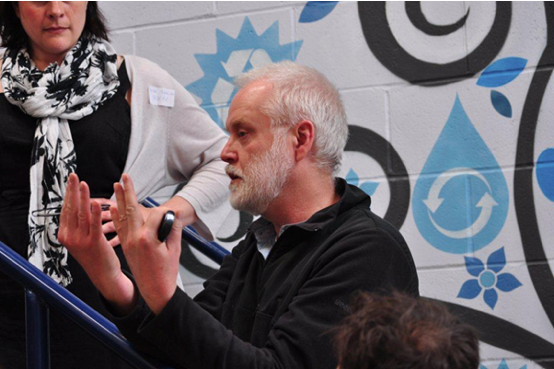GBE > Encyclopaedia > Files > Q+A > G#16244
Primitive Materials Future Building Q+A
Primitive Materials in Future Building Q+A
About:
Are ‘primitive’ materials the building blocks of tomorrow?
Some text is struck out to keep to webinar time limits, it is included here for a more comprehensive response.
Q UK GBC
A Brian Murphy of Green Building Encyclopaedia
Q1 What are the ‘primitive’ materials that have been used historically, and how can they be successfully used in modern construction?
- Lets not be put off by ‘primitive’
- I prefer simple: unsophisticated, uncomplicated; raw: natural, grown; historic: indigenous, local, traditional: and probably most important tried and tested, survived the test of time
- Cement-Free, Plastic-free, PVC-free, VOC-Free, formaldehyde-free, ZODP, ZGHGP, Carbon Black-free, titanium dioxide-free
- Reduce or eliminate reliance on Chemistry, Hydro-Carbons, Plastics, Synthetics, Off gassing, Adhesives, Binders, Admixtures, composites, conglomerates, polymer migration,
- Skills training may have happened but ‘lack of time to care’ prevails in our ‘fiduciary driven industry’
- Simple may well find its place again.
- I am a firm believer in the right materials, with the right properties for the right application in the right places
- Sometimes that has to be plastic or cement
- Healthy, Environmental, Resourceful, Appropriate, Competent, Effective, Yardstick
- Green Buildings are rarely metal-free, plastic-free or cement-free they all have a role to play, we can keep them to a minimum
The ‘primitive’ materials
- Timber
- In the round: posts, beams, fence posts
- Quartered: Fencing rails, Wattle for daub, staking of thatch
- Ads then Machined: Joists, Rafters, Columns, battens
- Brettstapel: Solid wood panels without glues
- Less Primitive:
- Laminated: Ply, Gluelam, Crosslam, LVL,
- Waste particles, wood based boards: MDF, Chipboard, OSB
- Earth Construction:
- Earth Bricks/Blocks
- Soft and malleable: make airtight
- Set: Sun dried: add thermal mass
- Fired
- Bricks
- Extruded cellular hollow blocks: Insulating
- Turf with grasses as roofing
- Turf as mortar in stone walling
- Rammed Earth
- Clay
- Chalk
- Chalk and Flint (Pines Calyx)
- Reinforced stabilised with lime or cement
- Reinforced with plant stalk
- Decorative: Colours, Mineral, Aggregates
- CAT retail building beautiful glass sheet stop people licking it
- Clay & Straw
- Cob
- Clay and Tyres in Earth ships
- Can be shaped with scissors or chain saw
- With Boots: DPC/M and Hat: overhanging roof
- Low skill entry, ideal DIY, BIY
- Lime or earth render and plaster
- Natural insulants
- Wood derivative:
- Cellulose flake, recycled newspaper/magazines
- Dense wood fibre: batts, boards
- Plants
- Flax
- Hemp shive+lime (Hemp-lime) Hemcrete
- Straw in board format (but does not like UK climate)
- Coconut husk
- Cotton (but chemically intensive)
- Grass
- Animal
- Sheep’s Wool
- Wood derivative:
- Earth Bricks/Blocks
Images
- Centre for Alternative Technology (CAT), Wales
- Sheep’s wool insulation
- Straw and other shrubs
- Straw bale construction
- Modular, big and heavy blockwork,
- Dense setting on harvester: Good U value
- Framed option, spacing responding to modules
- In walls and even in roofs
- Straw as Thatch
- Thickness increases with refurbishments
- Low density good conductivity Insulation
- Solar radiation protection
- (poor U value Today)
- Straw bale construction
Why use ‘primitive’ materials
- Primary reason:
- Renewable in our lifetimes, (Trees)
- Rapidly renewable (seasonal crops)
- Non-renewables
- Fossil (oil and derivatives),
- Stone (mostly)
- Lowering carbon emissions
- Absorbing carbon from the atmosphere to grow the plants (Carbon Sequestration)
- Low energy manufacturer
- Conventional Building +50 tonnes of Carbon
- Bio-based building -50 tonnes of carbon
- You need to choose the right materials with the right properties
- Reducing overheating
- Conventional insulations (plastics and mineral fibres)
- Let the radiant heat of the sun into buildings
- Once inside will not let the heat out (winter thermal conductivity insulation)
- Primitive materials (others too) don’t let radiant heat in in the first place
- You need to choose the right materials with the right properties
- (Decrement factor: specific heat capacity, density, k value)
- Moisture Vapour Permeable
- Breathes and lets the moisture out
- Vapour open construction (no VCL and BM, use ATL and WTL)
- Hygro-scopic insulation absorbs moisture from the air pockets into the fibre
- Lets the insulation insulate
- Moisture in Hydro-phobic insulation cannot be absorbed so it stays moist and stops insulating
- You need to choose the right materials with the right properties
- Impact on health and wellbeing
- Overheating can lead to a range of health problems but ultimately death
- 30,000 died in summer of 2003 in EU, 300 in UK
- Moisture vapour condensing on cold non-absorbent surfaces reactivates spores in the atmosphere
- Spores lead to mould, mould leads to asthma, toxic mould leads to death and unusable buildings
- Uncomplicated materials free from chemicals and plastics do not off-gas VOC, formaldehyde, etc.
- Airtightness without energy/carbon intensive ventilation makes building unhealthy or deadly
- There are healthy building standards becoming popular trying to address this
- Unfortunately some people react badly to natural materials
- They may never get to benefit from all the other natural material properties
- Wool irritates skin
- like glass or stone wool insulation irritates skin
- Dust may irritate breathing (still use dust masks)
- Usually the materials are in the construction
- Others are on the surface
- Overheating can lead to a range of health problems but ultimately death
Q2 What are the barriers to integrating more sustainably sourced natural materials in new projects?
The barriers
- Existing Supply chain – standard construction
- Supply chain grip, Price structures, Familiar companies, Familiar people, obligations
- They know what they know, they have the skills training,
- They know how long it takes, they know how to price it
- They know how to make a profit and how to cut corners
- All supports and reinforces business as usual
- Clients/project teams/QSs on board
- All must be facing in the same direction
- If the client want primitive she needs a primitive team surrounding her
- Cost plans must be based on primitive materials used in primitive ways priced by primitives
- Cost plans are usually based on violet materials
- Building Price Books are violet prices
- Technical knowledge
- Primitive manufacturer must aspire towards British Gypsum’s White Book
- One step as a time it will take years
- Knowledge Transfer: Physics of Building, Science of materials, crunching of numbers
- Every permutation of products, accessories, components > assemblies and performances
- Manufacturers Associations (ASBP, HL, BB) Authoritative literature
- Highly illustrated, 3D, iconography
- BDA, AJ, Cape, (1970’s)
- Approved documents
- Building Regulations (Performance = unlimited options)
- Approved Documents: (Familiar, conventional, Tried and tested solutions, tables of sizes)
- Tertiary Documents by manufacturers associations give guidance on other methods
- BCT and RSPB created theirs with my help
- Lack of data
- Traditional materials have known performances and thicknesses (BRAD and test books)
- But eroded by bad practices
- New and primitive may not be know and promoters of them need to support us to specify them
- Properties tables
- Performance tables
- Data Sets, Equations, Calculators, Output tables
- Traditional materials have known performances and thicknesses (BRAD and test books)
- Primitive manufacturer must aspire towards British Gypsum’s White Book
Illustration:
- Timber beam on rammed earth walls, Pines Calyx
Q3 How do we make a conscious use of these materials more accessible to design team and technically achievable?
What can be done to increase use of natural materials?
- Researching on physical properties
- Brexit means we will no longer have access to 50% EU funding for R&D
- Except as consultant to EU projects, but will we be invited to the party?
- Reliant upon UK companies paying 100% to UK universities to do R&D for them
- An unlikely scenario, UK has a bad reputation for % of income on R&D
- UK Government must step up to the plate and provide better access to better funding
- EU R&D Contributions redirected to UK companies
- Build on R&DIY models
- PEF not LCA and EPD
- Individual products (EC) not Elemental Assemblies (BRE GGtS)
- Testing materials / collecting data
- Push to discover the limits
- Not driven by (BRE GGtS) averages
- Incentives to improve not BAU
- Its expensive but essential
- Collate all past know-how
- Share failures to learn from (AECB great at this and PassiveHouse+ will benefit)
- Capture Guru Know-how before its too late
- Reinforce it with Evidence
- Enable Evidence Based Design
- Updating literature
- Create it in the first place
- Understand we do not know what the manufacturer knows
- Better Literature please
- Graphic Illustrated like AJ and BDA in the 1970’s
- Give designers useful tools (Specifications, BIM)
- B‘I’M PDS Product Data Sheets (first, its cheaper)
- BI‘M’ ready Models (later, they are expensive)
- Robust Specifications (BIM-ready Uniclass)
- Data Sets, Equations, Excel Calculators, Targets, Results tables
- U & Decrement, PEF, LCA, EC, EE, SC, Waste, Calculators
- Updating Policies and Building Regulations
- Manufacturers Associations with Authoritative Documents
- representing their sector capabilities
- Written as Tertiary Document to the BRAD
- Then go see the DCLG and get cites in the Ads
- Challenge targets no more business as usual
- Encourage a drive towards low or zero carbon future built with primitive materials
- Manufacturers Associations with Authoritative Documents
- Push to discover the limits
- Brexit means we will no longer have access to 50% EU funding for R&D
Illustration:
- Timbrel Dome roof, Pines Calyx
© GBE NGS ASWS BrianSpecMan aka Brian Murphy
1st December 2017 – 11th December 2017
Primitive Materials in Future Building Q+A
Images:
Event Logo
 Organiser Logo
Organiser Logo
 Cover Slide
Cover Slide
Handout Cover
Speaker

Brian Murphy aka BrianSpecMan BRM @ Build4 CAPEM Showroom
© GBE NGS ASWS BrianSpecMan aka Brian Murphy
1st December 2017 – 7th December 2017
Primitive Materials in Future Building Q+A
See also:
GBE Events
GBE Webinar
- Primitive Materials Future Building (Webinar) G#16202
GBE CPD
- Materials
- Properties
- Products
- Insulation: Thermal and Acoustic
- Load bearing
- Space division
GBE CPD Titles
GBE CPD Satisfied Customers
GBE Checklist
- Rammed Earth Walling
- Earth Construction
- Unfired Clay
- J40 Damp Proofing
- P10 Thermal Acoustic and Fire Proofing
- M20 Render/Plaster
- M10 Screed/Flooring
- F42 Straw Bale
- H9_ Straw Thatch
- Z21 Turf mortar
- Z21 Earth Mortar
GBE Jargon Buster
- Primitive
- Unsophisticated
- Traditional
- Natural
- Indigenous
- Bio-based
© GBE NGS ASWS BrianSpecMan aka Brian Murphy
1st December 2017 -11th December 2017

